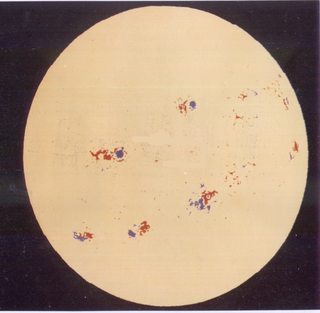
A geomagnetic storm, also known as a magnetic storm, is a temporary disturbance of the Earth's magnetosphere caused by a solar wind shock wave and/or cloud of magnetic field that interacts with the Earth's magnetic field.

Solar Cycle 24 is the most recently completed solar cycle, the 24th since 1755, when extensive recording of solar sunspot activity began. It began in December 2008 with a minimum smoothed sunspot number of 2.2, and ended in December 2019. Activity was minimal until early 2010. It reached its maximum in April 2014 with a 23 months smoothed sunspot number of 81.8. This maximum value was substantially lower than other recent solar cycles, down to a level which had not been seen since cycles 12 to 15 (1878-1923).

Solar cycle 5 was the fifth solar cycle since 1755, when extensive recording of solar sunspot activity began. The solar cycle lasted 12.3 years, beginning in April 1798 and ending in August 1810. The maximum smoothed sunspot number observed during the solar cycle was 82.0, in February 1805, and the starting minimum was 5.3.

Solar cycle 6 was the sixth solar cycle since 1755, when extensive recording of solar sunspot activity began. The solar cycle lasted 12.8 years, beginning in August 1810 and ending in May 1823. The maximum smoothed sunspot number observed during the solar cycle was 81.2, in May 1816, and the starting minimum was 0.0.

Solar cycle 9 was the ninth solar cycle since 1755, when extensive recording of solar sunspot activity began. The solar cycle lasted 12.4 years, beginning in July 1843 and ending in December 1855. The maximum smoothed sunspot number observed during the solar cycle was 219.9, and the starting minimum was 17.6. During the solar cycle minimum transit from solar cycle 9 to solar cycle 10, there were a total of 655 days with no sunspots.

Solar cycle 10 was the tenth solar cycle since 1755, when extensive recording of solar sunspot activity began. The solar cycle lasted 11.3 years, beginning in December 1855 and ending in March 1867. The maximum smoothed sunspot number observed during the solar cycle was 186.2, and the starting minimum was 6.0. During the transit from solar cycle 10 to 11, there were a total of 406 days with no sunspots.

Solar cycle 11 was the eleventh solar cycle since 1755, when extensive recording of solar sunspot activity began. The solar cycle lasted 11.8 years, beginning in March 1867 and ending in December 1878. The maximum smoothed sunspot number observed during the solar cycle was 234.0, and the starting minimum was 9.9. During the minimum transit from solar cycle 11 to 12, there were a total of 1028 days with no sunspots.

Solar cycle 12 was the twelfth solar cycle since 1755, when extensive recording of solar sunspot activity began. The solar cycle lasted 11.3 years, beginning in December 1878 and ending in March 1890. The maximum smoothed sunspot number observed during the solar cycle was 124.4, and the starting minimum was 3.7. During the minimum transit from solar cycle 12 to 13, there were a total of 736 days with no sunspots.

Solar cycle 13 was the thirteenth solar cycle since 1755, when extensive recording of solar sunspot activity began. The solar cycle lasted 11.8 years, beginning in March 1890 and ending in January 1902. The maximum smoothed sunspot number observed during the solar cycle was 146.5, and the starting minimum was 8.3. During the minimum transit from solar cycle 13 to 14, there were a total of 934 days with no sunspots.

Solar cycle 14 was the fourteenth solar cycle since 1755, when extensive recording of solar sunspot activity began. The solar cycle lasted 11.5 years, beginning in January 1902 and ending in July 1913. The maximum smoothed sunspot number observed during the solar cycle was 107.1, in February 1906, and the starting minimum was 4.5. During the minimum transit from solar cycle 14 to 15, there were a total of 1023 days with no sunspots.

Solar cycle 16 was the sixteenth solar cycle since 1755, when extensive recording of solar sunspot activity began. The solar cycle lasted 10.1 years, beginning in August 1923 and ending in September 1933. The maximum smoothed sunspot number observed during the solar cycle was 130.2, and the starting minimum was 9.4. During the minimum transit from solar cycle 16 to 17, there were a total of 568 days with no sunspots.
Solar cycle 17 was the seventeenth solar cycle since 1755, when extensive recording of solar sunspot activity began. The solar cycle lasted 10.4 years, beginning in September 1933 and ending in February 1944. The maximum smoothed sunspot number observed during the solar cycle was 198.6, and the starting minimum was 5.8. During the minimum transit from solar cycle 17 to 18, there were a total of 269 days with no sunspots.
Solar cycle 18 was the eighteenth solar cycle since 1755, when extensive recording of solar sunspot activity began. The solar cycle lasted 10.2 years, beginning in February 1944 and ending in April 1954. The maximum smoothed sunspot number observed during the solar cycle was 218.7, and the starting minimum was 12.9. During the minimum transit from solar cycle 18 to 19, there were a total of 446 days with no sunspots.

Solar cycle 19 was the nineteenth solar cycle since 1755, when extensive recording of solar sunspot activity began. The solar cycle lasted 10.5 years, beginning in April 1954 and ending in October 1964. The International Geophysical Year occurred at the peak of this solar cycle.

Solar cycle 20 was the twentieth solar cycle since 1755, when extensive recording of solar sunspot activity began. The solar cycle lasted 11.4 years, beginning in October 1964 and ending in March 1976. The maximum smoothed sunspot number observed during the solar cycle was 156.6, and the starting minimum was 14.3. During the minimum transit from solar cycle 20 to 21, there were a total of 272 days with no sunspots.

Solar cycle 21 was the 21st solar cycle since 1755, when extensive recording of solar sunspot activity began. The solar cycle lasted 10.5 years, beginning in March 1976 and ending in September 1986. The maximum smoothed sunspot number observed during the solar cycle was 232.9, in December 1979, and the starting minimum was 17.8. During the minimum transit from solar cycle 21 to 22, there were a total of 273 days with no sunspots. The largest solar flare of this cycle (X15) occurred on July 11, 1978.

Solar cycle 22 was the 22nd solar cycle since 1755, when extensive recording of solar sunspot activity began. The solar cycle lasted 9.9 years, beginning in September 1986 and ending in August 1996. The maximum smoothed sunspot number observed during the solar cycle was 212.5, and the starting minimum was 13.5. During the minimum transit from solar cycle 22 to 23, there were a total of 309 days with no sunspots.

Solar cycle 23 was the 23rd solar cycle since 1755, when extensive recording of solar sunspot activity began. The solar cycle lasted 12.3 years, beginning in August 1996 and ending in December 2008. The maximum smoothed sunspot number observed during the solar cycle was 180.3, and the starting minimum was 11.2. During the minimum transit from solar cycle 23 to 24, there were a total of 817 days with no sunspots. Compared to the last several solar cycles, it was fairly average in terms of activity.

The three-day May 1921 geomagnetic storm, also known as the New York Railroad Storm, was caused by the impact of an extraordinarily powerful coronal mass ejection on Earth's magnetosphere. It occurred on 13–15 May as part of solar cycle 15, and was the most intense geomagnetic storm of the 20th century.

Solar cycle 25 is the current solar cycle, the 25th since 1755, when extensive recording of solar sunspot activity began. It began in December 2019 with a minimum smoothed sunspot number of 1.8. It is expected to continue until about 2030.

















